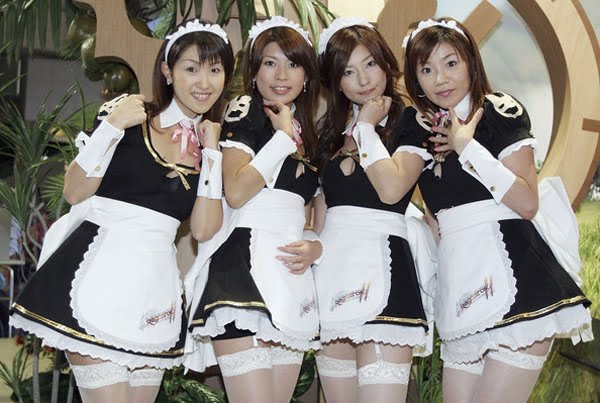Welcome to DU!
The truly grassroots left-of-center political community where regular people, not algorithms, drive the discussions and set the standards.
Join the community:
Create a free account
Support DU (and get rid of ads!):
Become a Star Member
Latest Breaking News
General Discussion
The DU Lounge
All Forums
Issue Forums
Culture Forums
Alliance Forums
Region Forums
Support Forums
Help & Search
History of Feminism
Related: About this forumJapan’s ‘Moe’ obsession: the purest form of love, or creepy fetishization of young girls?

by Tim Hornyak
Special To The Japan Times
Anyone who has visited Tokyo’s Akihabara district in the past decade will have run into countless images of cartoonish girls: in posters, in figurines and in the form of real women dressed up as French maids.
The cute cartoon girls, or bishōjo, are visual hieroglyphics in the language of otaku (obsessive) desire. Their dewy saucer-like Bambi eyes seem to encode an inscrutable message that can be bewildering to the uninitiated. Why the endless repetition of this waif? Is there some pre-”Sailor Moon” archetype they are trying to recapture? What does it all mean?
Otaku scholar Patrick W. Galbraith has tried to decipher the semiotics by focusing on one keyword in the otaku lexicon: moe (for some reason written with a French accent over the “e” in his book, unlike “anime”). It’s from the Japanese verb moeru, meaning either to burst into bud or to burn, depending on the way it’s written. In geek-speak, it signifies the emotional attachment that otaku feel for their favorite characters. Galbraith’s “The Moe Manifesto” is a collection of 19 interviews with manga and anime artists and producers that aims to better understand what motivates otaku.
I confess that although I enjoy quality anime, I’m no fan of moe. To me it is shorthand for moeru gomi (burnable trash). But I read this book in hopes of gaining insight into what would make grown men — and many if not most otaku are such — obsess over cartoon girls. Is it a sexual fetish? A Peter Pan complex? Or some other unfulfilled desire?
http://www.japantimes.co.jp/culture/2014/07/26/books/book-reviews/japans-moe-obsession-purest-form-love-creepy-fetishization-young-girls/#.U9Vy5kDNvMo
InfoView thread info, including edit history
TrashPut this thread in your Trash Can (My DU » Trash Can)
BookmarkAdd this thread to your Bookmarks (My DU » Bookmarks)
1 replies, 4072 views
ShareGet links to this post and/or share on social media
AlertAlert this post for a rule violation
PowersThere are no powers you can use on this post
EditCannot edit other people's posts
ReplyReply to this post
EditCannot edit other people's posts
Rec (4)
ReplyReply to this post
1 replies
 = new reply since forum marked as read
Highlight:
NoneDon't highlight anything
5 newestHighlight 5 most recent replies
= new reply since forum marked as read
Highlight:
NoneDon't highlight anything
5 newestHighlight 5 most recent replies
Japan’s ‘Moe’ obsession: the purest form of love, or creepy fetishization of young girls? (Original Post)
yuiyoshida
Jul 2014
OP
redqueen
(115,103 posts)1. Oh, Goddess...
Creepy? Perhaps. It may be reassuring to those who feel that moe “love” is simply pedophilia — a word that doesn’t appear once in Galbraith’s book — but it is hard not to feel revulsion over some of the illustrations in the book, particularly those by artist Pop, who depicts a prepubescent cartoon girl, legs splayed out and crotch thrust at the viewer. “I like thighs, and so I draw full-body portraits from a low-angle perspective,” Pop is quoted as saying. (Decades after the rest of the developed world, Japan last month finally outlawed the possession of child pornography, but the ban doesn’t affect anime and manga publishers.)
The event inspired the book’s title, although it contains no manifesto per se. What it does offer is some very deep inside baseball on the origins and manifestations of moe. Like-minded fans will appreciate its detailed account of the magazine Manga Burikko, where the word “otaku” surfaced in the early 1980s in a column by Akio Nakamori, as well as the popularization of the word “moe” following the film “Densha Otoko (Train Man).” Readers will also learn about how the producers of the 1982-83 anime “Maho no Princess Minky Momo (Magical Princess Minky Momo),” aimed squarely at girls 3 to 5 years old, were stunned to find it had been appropriated by otaku: Adult male devotees had formed a fan club.
There really are no words.